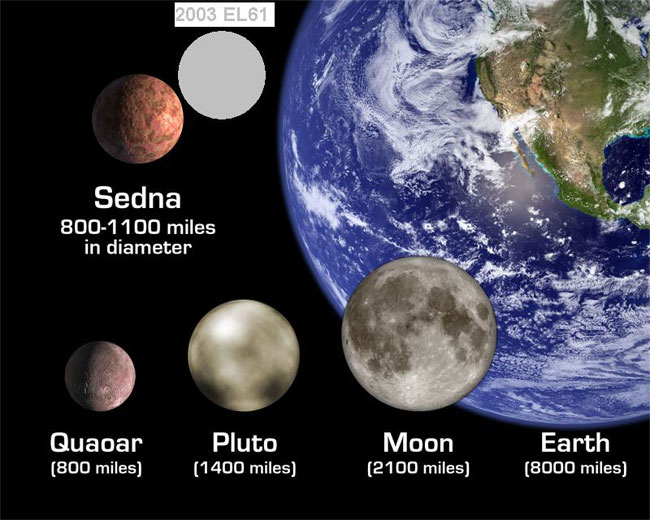Large New World Discovered Beyond Neptune

EDITOR'S NOTE: In separate news announced late Friday, July 29 2005, astronomers said they had indeed found another object that is larger than Pluto. They are calling it the 10th Planet. STORY
The story below was written Friday morning and is no longer the big news of the day. It is accurate, however, and discusses a seperate world announced Friday, one that is smaller than Pluto.
A newfound object in our solar system's outskirts may be larger than any known world after Pluto, scientists said today.
It also has a moon.
Designated as 2003 EL61, the main object in the two-body system is 32 percent as massive as Pluto and is estimated to be about 70 percent of Pluto's diameter.
Other news reports that the object could be twice as big as Pluto are false, according to two astronomers who found the object in separate studies and another expert who has analyzed the data.
If the mass is only one-third that of Pluto, then theory holds that it can't be larger than Pluto, according to Brian Marsden of the Minor Planet Center, which serves as a clearinghouse for data on all newfound objects in the solar system.
Get the Space.com Newsletter
Breaking space news, the latest updates on rocket launches, skywatching events and more!
Marsden, who was not involved in the discovery but has reviewed the data, told SPACE.com that the mass estimate is very firm, within 1 or 2 percent. "I don't think it is bigger than Pluto," he said.
Where it fits in
This is still a big world, once again raising the prospect that something larger than Pluto might still lurk out there.

Scientists base their size calculations in part on the object's reflectivity. Since they don't know exactly how much the surface brightness of distant objects varies, there is some wiggle room in their size estimates.
A team led by Mike Brown of Caltech has been observing 2003 EL61 for a year but was seeking more data before announcing the discovery. Brown said today it may possibly be larger than Sedna, which has been the largest known world beyond Neptune other than Pluto.
Sedna is between 800 and 1,100 miles in diameter. Pluto is about 1,400 miles across.
Brown figures 2003 EL61 has a diameter of around 930 miles.
Is there any chance it is bigger than Pluto?
"No," Brown said in a telephone interview. "Definitely not."
In fact, Brown's team got the new data they had been waiting for, from the Spitzer Space Telescope, last week. While not fully analyzed, he said the Spitzer observations show "absolutely" that the object is not bigger than Pluto.
Who gets credit?
The object was spotted independently by a group led by Jose-Luis Ortiz of the Sierra Nevada Observatory in Spain. Ortiz' team announced the finding in astronomy circles recently and the finding, including the claim that it might be twice as big as Pluto, was reported by an online news site today.
Ortiz said that based on his team's observations, there was one outlying theory could allow 2003 EL61 to be larger than Pluto, but he does not think it is right.
"I do not think it is larger than Pluto," Ortiz told SPACE.com today.
Brown was surprised last night to learn that Ortiz' group had independently found the object, which only yesterday gained the tag 2003 EL61 from the Minor Planet Center. It was a rare case of one group of astronomers unwittingly scooping another.
Brown said that Ortiz' group rightfully deserves credit for making the discovery.
About that moon
2003 EL61 orbits the Sun on an elliptical path beyond Neptune in a region of space known as the Kuiper Belt. It is significantly inclined to the main plane of the solar system where most of the planets travel. It is one of several objects out there now known to have a satellite.
The moon around 2003 EL61 is small, making up only about 1 percent of the mass of the system, Brown said.
"This satellite is the smallest satellite relative to its primary known in the Kuiper belt," Brown said. "Pluto's satellite, Charon, is about 10 percent of the mass of Pluto.
Marsden, of the Minor Planet Center, said it is surprising the object was not discovered earlier. He said it was probably just barely too faint to be spotted in the sky survey done by Clyde Tombaugh that led to the discovery of Pluto 75 years ago.
Brown's team first spotted 2003 EL61, which had no name at the time, using the Samuel Oschin Telescope at Palomar Observatory on May 6, 2004. They did not realized they had found it until Dec. 28, 2004, after scrutinizing their data in and ongoing effort to find Kuiper Belt Objects.
In a series of three images, the object is seen moving across the sky in relation to relatively fixed background stars.
Ortiz's group initially detected the object in 2003 and spotted it again this year, leading to their announcement yesterday.
- Controversial Proposal Would Boost Solar System's Planet Tally to 12
- Pluto Hit By Twin to Create Moon, Study Suggests
- Crazy Names: The Solar System's Nomenclature Wars
Join our Space Forums to keep talking space on the latest missions, night sky and more! And if you have a news tip, correction or comment, let us know at: community@space.com.

Rob has been producing internet content since the mid-1990s. He was a writer, editor and Director of Site Operations at Space.com starting in 1999. He served as Managing Editor of LiveScience since its launch in 2004. He then oversaw news operations for the Space.com's then-parent company TechMediaNetwork's growing suite of technology, science and business news sites. Prior to joining the company, Rob was an editor at The Star-Ledger in New Jersey. He has a journalism degree from Humboldt State University in California, is an author and also writes for Medium.









